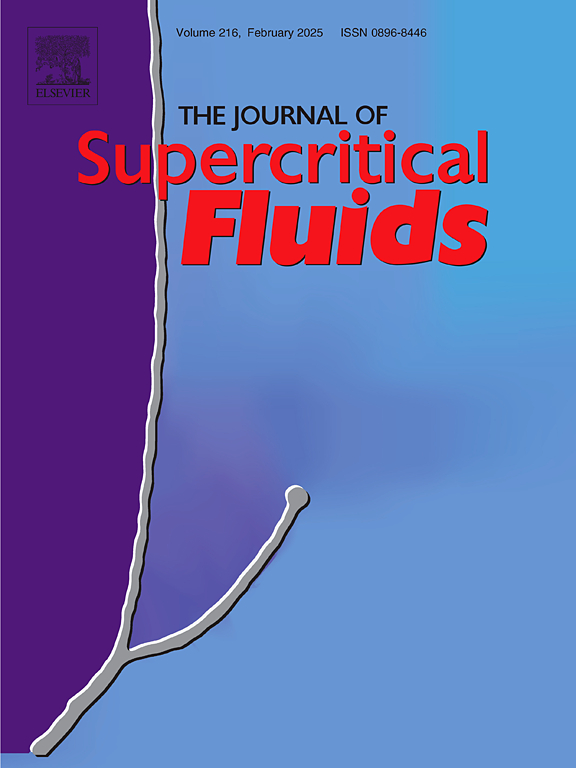A simple and efficient method for preparing high-expansion, low-shrinkage poly(ether-block-amide) foam
IF 4.4
3区 工程技术
Q2 CHEMISTRY, PHYSICAL
引用次数: 0
Abstract
Poly(ether-block-amide) (PEBA) is limited by its insufficient matrix strength and low melt viscoelasticity, which adversely affect its foaming performance and present significant challenges for preparing high performance PEBA foams. To overcome these limitations, this work introduces an epoxy chain extender KL-E4370B to modify PEBA via chain extension. The results demonstrate that the modified PEBA achieves a markedly higher branching degree, accompanied by a three order of magnitude increase in complex viscosity and storage modulus. These improvements elevate the expansion ratio from 22.05 to 26.82 and extend the foaming temperature window by 70 °C. However, the modification also leads to a decline in crystallinity performance, characterized by a 5.28 % reduction in crystallization temperature, a 13.07 % decrease in crystallinity, and a 34.62 % slowdown in crystallization rate. These changes lead to significant foam shrinkage, with a shrinkage rate of up to 83.59 % and a recovery rate as low as 21.66 %, which compromises dimensional stability. To address these issues, a secondary N2 foaming assisted gas exchange method was implemented. This approach not only restores the expansion ratio of the shrunken foam but also surpasses the initial expansion ratio achieved by primary CO2 foaming. Furthermore, increasing the saturation time or pressure enhances the solubility of N2 in PEBA, thereby further improving the expansion ratio of foam. Ultimately, this study successfully fabricates a PEBA foam material with an expansion ratio of up to 44.17 and a shrinkage rate as low as 40 %. This work provides a simple and effective strategy for producing high-expansion, low-shrinkage thermoplastic elastomer foams.
一种制备高膨胀低收缩聚醚块酰胺泡沫的简单有效方法
聚醚嵌段酰胺(PEBA)的基体强度不足,熔体粘弹性较低,这对其发泡性能产生了不利影响,为制备高性能PEBA泡沫材料带来了重大挑战。为了克服这些局限性,本工作引入了环氧扩链剂KL-E4370B,通过扩链对PEBA进行改性。结果表明,改性后的PEBA分支度明显提高,复合粘度和存储模量提高了3个数量级。这些改进使膨胀比由22.05提高到26.82,发泡温度窗延长了70℃。然而,改性也导致结晶度性能下降,结晶温度降低5.28 %,结晶度降低13.07 %,结晶速率降低34.62 %。这些变化导致泡沫明显收缩,收缩率高达83.59 %,回收率低至21.66 %,影响尺寸稳定性。为了解决这些问题,实施了二次N2发泡辅助气体交换方法。这种方法不仅恢复了收缩泡沫的膨胀比,而且超过了一次CO2发泡所达到的初始膨胀比。此外,增加饱和时间或压力可以提高N2在PEBA中的溶解度,从而进一步提高泡沫的膨胀率。最终,本研究成功制备出膨胀率高达44.17,收缩率低至40% %的PEBA泡沫材料。这项工作为生产高膨胀、低收缩的热塑性弹性体泡沫提供了一种简单有效的策略。
本文章由计算机程序翻译,如有差异,请以英文原文为准。
求助全文
约1分钟内获得全文
求助全文
来源期刊

Journal of Supercritical Fluids
工程技术-工程:化工
CiteScore
7.60
自引率
10.30%
发文量
236
审稿时长
56 days
期刊介绍:
The Journal of Supercritical Fluids is an international journal devoted to the fundamental and applied aspects of supercritical fluids and processes. Its aim is to provide a focused platform for academic and industrial researchers to report their findings and to have ready access to the advances in this rapidly growing field. Its coverage is multidisciplinary and includes both basic and applied topics.
Thermodynamics and phase equilibria, reaction kinetics and rate processes, thermal and transport properties, and all topics related to processing such as separations (extraction, fractionation, purification, chromatography) nucleation and impregnation are within the scope. Accounts of specific engineering applications such as those encountered in food, fuel, natural products, minerals, pharmaceuticals and polymer industries are included. Topics related to high pressure equipment design, analytical techniques, sensors, and process control methodologies are also within the scope of the journal.
 求助内容:
求助内容: 应助结果提醒方式:
应助结果提醒方式:


